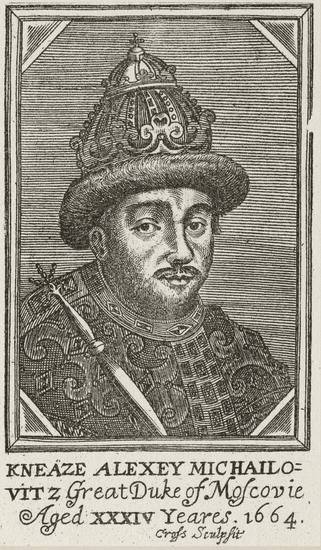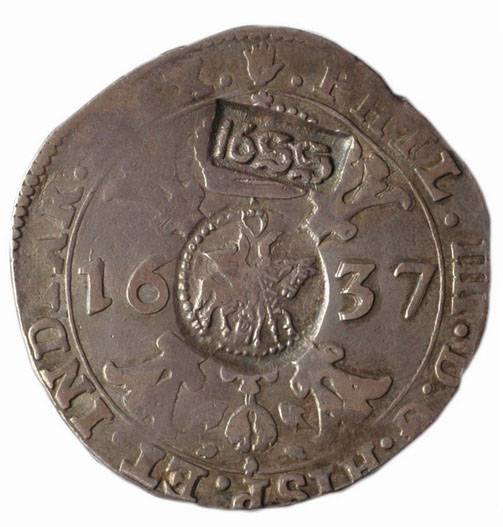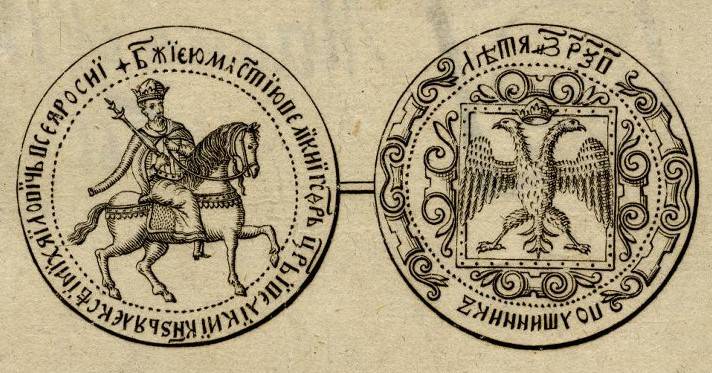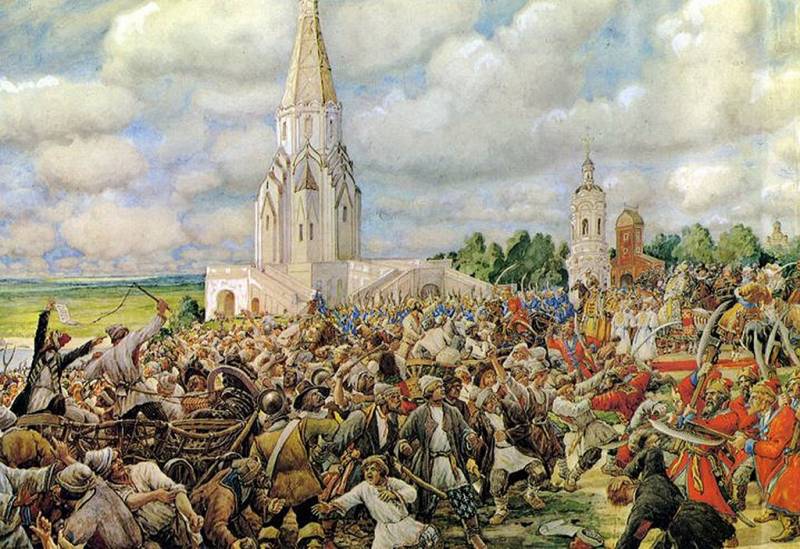"Copper Riot"
The people went to Kolomenskoye and no longer asked, but demanded that Tsar Alexei Mikhailovich give them traitors for reprisal, threatening
Polish front
The Russian-Polish war (1654-1667) continued for the Western Russian lands. A difficult war required money, people, and various material resources. Naturally, this worsened the situation of the common people, who were already suffering from the development of the policy of serfdom on the part of the Romanov governments.
In addition, the situation at the front was far from victorious. Moscow and Warsaw concluded the Vilna truce in 1656. It was connected with the outbreak of the Polish-Swedish war. The Swedes successfully beat the Poles and captured most of the Commonwealth - the so-called. Swedish flood 1656–1660
The tsarist government is making a strategic mistake. Instead of finishing off Poland together with Sweden and taking all the South Russian and West Russian lands, Moscow decides that the Swedes will become a threat to us (although Sweden could not absorb all of Poland and would simply get bogged down there, which eventually happened).
The government of Alexei Mikhailovich concludes a truce with the Poles and starts a war with Sweden. As a result, Poland, which suffered defeat, both on the Russian and Swedish fronts, was saved from complete disaster. And Russia didn’t get anything from the war with the Swedes, it only missed a favorable opportunity to finish off Poland, lost time and resources.
The Poles were in no hurry to put up. On the contrary, they prepared new troops, slowly occupied towns and towns. Russia responded with military demonstrations. The Polish side promised again, but everything was limited to chatter and impudent demands.
The Vilna truce with the Commonwealth caused a certain misunderstanding between Moscow and Hetman Bohdan Khmelnitsky, who warned Tsar Alexei Mikhailovich about the deceit of the Poles. Khmelnitsky reasonably believed that Poland should be finished off, and Sweden should be our ally in this matter.
And after the death of Bogdan, his successor Ivan Vyhovsky tore up the Treaty of Pereyaslav and signed the Treaty of Hadiach with the Commonwealth on the return of the Hetmanate to the rule of the Polish crown. The hetman strengthened the alliance with the Crimean Khanate and invited the Tatars. Vygovsky and the Crimeans went on the offensive. Troubles begin in Little Russia: the struggle between the pro-Moscow and pro-Polish parties. Russia had to urgently organize a rebuff to the new enemy.
A hard struggle went on with varying success. Prince Yuri Dolgoruky in October 1658 defeated Hetman Gonsevsky near Vilna. But in Little Russia, Vyhovsky went on the offensive. In February 1659, the Russian army of Prince Ivan Khovansky in the battle of Myadel (White Russia) defeated the Lithuanian army of Yuditsky. In June 1659, the Cossacks of Vygovsky and the Crimeans near Konotop defeated the Russian detachment of Pozharsky, Lvov and the Cossacks of Bespaly. Ataman Serko responded with a successful blow to the Nogai pastures. Soon Vygovsky is defeated. Yury Khmelnytsky was elected Hetman.
At the start of the 1660 campaign, Khovansky's Russian army liberated Brest and most of Russian Lithuania. However, in May, the Poles signed a truce with the Swedes and transferred troops to the Russian front. Polish-Lithuanian troops go on a counteroffensive, occupy the western and central parts of Lithuania. In September-October, in the battle on the Basya River, Dolgorukov's army stops the offensive of the Polish-Lithuanian troops. Only the eastern part of the Grand Duchy of Lithuania remains behind the Russian army. In the south, the Russian army of Sheremetev was defeated by the Polish-Crimean troops in the battles near Lyubar and Chudnov. Khmelnytsky was defeated near Slobodische and signed the Slobodischensky treaty, under the terms of which the Hetmanate returned to the Commonwealth. Sheremetev capitulated and promised to leave the Left Bank.
However, the governor Yuri Baryatinsky, who led the defense of Kyiv, refused to surrender the city, saying:
In Pereyaslav, the people, led by the hetman Yakim Somko, Yury Khmelnytsky's uncle, also refused to capitulate. Somko swore
The Poles were unable to build on the first success.
During the campaign of 1661–1662, the hard struggle continues. The Russians lost Mogilev and Borisov, after a stubborn 16-month defense, Vilna fell. On the southern flank, the tsarist troops and the left-bank Cossacks twice repulsed the attempts of the Khmelnitsky Cossacks and the Crimeans to take Pereyaslavl. The Cossacks, Poles and Tatars of Khmelnytsky were defeated near Kanev.
As a result, Khmelnytsky was defeated and refused hetmanship. But the struggle for Little Russia continued. The ruin ended with the complete devastation of Right-Bank Russia.

rebellious age
Thus, the hard struggle with the Commonwealth, Sweden, the Crimean Khanate and traitors in Little Russia (a Cossack foreman who fought on the side of Poland, with the support of Crimea and Turkey) led to a serious economic crisis in the Russian kingdom. The human and material resources of the Russian state and people went to a bloody and protracted war. The confrontation dragged on due to the strategic mistakes of the tsarist government, and Russia was able to return only the Left-bank Lesser Russia.
On the other hand, the legal, material situation of the vast majority of the people (peasantry) was worsened by the feudal policy of the Romanovs. According to the Council Code, an unlimited period of investigation of fugitive peasants was announced. The landowner now had the right to return the fugitive himself, or even his descendants, with all the goods acquired on the run, if he could prove that it was from his estate that the peasant had fled. Also, even a debt-free peasant lost the right to change his place of residence - he became “strong”, that is, attached forever to the estate where he was found by the census of the 1620s. In the event of his departure, the Code prescribed forcibly returning a previously free person back along with the entire household and family.
The Code of Tsar Alexei Mikhailovich made a social revolution, depriving the majority of the country's population of the right to move freely and dispose of themselves, their labor and property. The position of the peasant is approaching that of a serf. His economy is more and more resolutely recognized as the property of the master. The peasant is already beginning to be regarded as the personal property of the master.
This became the foundation for a series of uprisings and a peasant war led by Stepan Razin. In the same direction, one can consider errors in tax policy (an increase in the tax burden, a several-fold increase in salt prices - the Salt Riot), Nikon's church reforms, which caused a split in the church, society and serious resistance from the people. Therefore, the XNUMXth century, and in particular the reign of Tsar Alexei Mikhailovich, is often called "rebellious" in Russian historiography.
Military and monetary reforms
After the losses of 9 years of the war, a number of failures in Russian Lithuania and Little Russia, Moscow had to essentially form a new army. It was created on the go, without stopping fighting. New units had to be recruited, armed and equipped. There was a third organization of the so-called. "regiments of the new order". During the Russo-Polish War, regiments of the new system became the main part of the armed forces. Soldiers and dragoon regiments were recruited from subordinate people for lifelong service. Duty was nationwide - at first a soldier was taken from 100, and then from 20-25 yards. Annually and monthly they were given cash and grain salaries or put on 12-25 quarters. During the war, at least 100 thousand people were recruited, of which 1663-50 thousand people were in the service by 60 in 55 soldier regiments.
It wasn't easy and it wasn't cheap. They recruited not only people, but also horses (from 60 yards). In 1662, an emergency tax was announced - the "fifth money". This time, the tsar did not convene the Zemsky Sobor, whose role was greatly weakened. The church at this time was in complete disarray. Nikon was sitting in New Jerusalem, still trying to claim power. They tried to "move" him.
The financial situation was worrying. In Russia, silver kopecks, money (1/2 kopeck) and polushki (1/4 kopeck), minted on flattened wire, were in circulation. On the territory of Lithuanian Russia and Little Russia, European coins were in circulation, minted on a round mug, both silver and copper. In order to resolve the issue of salaries in the troops and the establishment of a monetary system, in the Western Russian lands it was decided to switch to the European standard. To mint a new coin close to the European model. As a result, imitation of the Europeans made the reform a failure.
In 1654, the sovereign ordered that rubles be minted from the silver thalers (yefimok) accumulated in the treasury. Images and inscriptions were knocked down from foreign coins, and then their own brands were put on the resulting mug. However, the counting ruble with old kopecks weighed about 45–46 g. The weight of the thaler was 28–32 g. At the mint, 64 kopecks were minted from one efimka, while they were bought from foreigners for 50. went to the people.
Therefore, in 1655 the reform was corrected. Efimka-talers began to be minted on one side with two stamps: a rectangular stamp with the date "1655" and a round stamp of a kopeck (a rider on a horse). Appeared "Efimok with a sign." Efimok and the ruble were equal to 64 kopecks (by weight), although earlier the price ranged from 40 to 60 kopecks. A taler cut into four parts was minted, so a quarter (half-fifty dollars) appeared in circulation. A half-efimok coin was also introduced (a taler cut in half with a countermark). “Efimok with a sign” and his shares (half-efimok and quarter) went to the army, and were in circulation mainly in Little Russia. In the main part of Russia, this reform also did not go.
At the same time, the minting of copper coins began: fifty kopecks (50 kopecks), half-fifty kopecks (25 kopecks), hryvnia (10 kopecks), altyn (3 kopecks) and groshevik (2 kopecks). The coinage of the hryvnia may not have been started. Copper coins were coins with a forced rate (as, indeed, were the silver ruble and half-fifty).
Initially, the people willingly accepted copper kopecks as money familiar in appearance. However, the immoderate issue of copper kopecks, which were issued by five courts at once (two Moscow ones - Old and New, as well as courts in Novgorod, Pskov and Kukeynos), as well as restrictions on the acceptance of copper coins (taxes were collected in silver, and payments from the treasury were made in copper) led to their depreciation.
Rising prices. The authorities tried to limit their growth, but did not help. Merchants agreed to give the goods only at a fixed price, in silver. If copper - then more expensive. An illegal exchange arose - for one silver ruble they gave 4, 5, then 15 copper ones. In addition, counterfeiters proliferated. They were severely punished - beaten with a whip, exiled, chopped off their hands. But copper was already 20 times cheaper than silver, the benefit was too great. People took risks. Often this was done by the coin masters themselves, together with officials. It was difficult or even impossible to determine what kind of copper the coins were minted from: from the sovereign or private.

Revolt
Silver began to disappear from circulation. They bought him and hid him. The government issued new batches of new money. They tried to pay salaries to the troops. In Lithuania and Little Russia, they refused to accept copper. Rumors spread that the copper money was "fake".
War hardships, rising prices and taxes spun irritation and anger. On July 25 (August 4), 1662, anonymous letters appeared on the Lubyanka. It was written in them that the tsar's relatives Miloslavsky make counterfeit money and profit from this (the tsar married the daughter of Ilya Miloslavsky Maria), the bed-keeper Fyodor Rtishchev (one of the authors of the church reform that led to the split, and the author of the unsuccessful monetary reform) and the merchant Vasily Shorin, who collected "the fifth money" in the whole state. They were also accused of treason, of secret ties with the Poles. Interestingly, the same people who were accused of abuse during the Salt Riot became the object of popular hatred.
When they tried to remove the paper, the crowd did not give. The pogroms began. The estates of "traitors" were smashed. Shorin fled to the Kremlin. The rebels seized his son, forced him to "confess" that his father fled to Poland with "boyar letters". Part of the Muscovites went to the sovereign. Alexei Mikhailovich was in Kolomenskoye at that time, celebrating the birth of his daughter Feodosia. I stood in the temple at mass and was very surprised to learn about the turmoil in the capital. He himself went out to the crowd, urged them to disperse, promised to sort everything out. The sovereign assured that he would immediately go to Moscow. The people calmed down, fell back. A new crowd was pouring towards them, inflamed by the pogroms in the capital.
People again went to Kolomenskoye and no longer asked, but demanded to give them traitors for reprisal, threatening "if he would not give them back those boyars, and they would teach him to take them themselves, according to their custom." Governor Khovansky went to the rebels. He shouted that the tsar had already promised to investigate the accusation. They answered him, let Alexei Mikhailovich still hand over the "changeable" boyars for reprisal. Streshnev galloped up, urging them to calm down and disperse. They rushed at him with stakes, the boyar on horseback rushed into the Moscow River and escaped by swimming.
Meanwhile, archers and soldiers arrived in Kolomenskoye. After a new refusal to disperse, volleys followed. Already running people began to be beaten with whips, butts and reeds. Many jumped into the water and drowned. According to various estimates, the victims were from 3 to 7 thousand people. Up to 1 thousand people died. Some were wounded, crippled in the stampede.
G. Kotoshikhin, an official of the Ambassadorial Department, described this event as follows:
However, his news should be treated critically, since Kotoshikhin was a Westerner at that time and, having fled from Russia, created his work commissioned by the Swedish authorities.
Rumors of a copper riot swept through Russia, in some places there were new riots and small riots. The king entrusted the investigation to Khovansky. Several hundred people were arrested, breeders were executed, the rest were flogged and sent into exile. Removed some officials for "excesses". The merchants themselves realized that the time was dangerous, and prices were lowered.
The copper issue was gradually curtailed, the money was confiscated and melted down. The mints in Novgorod and Pskov were closed, and the issue of silver coins resumed.


Information